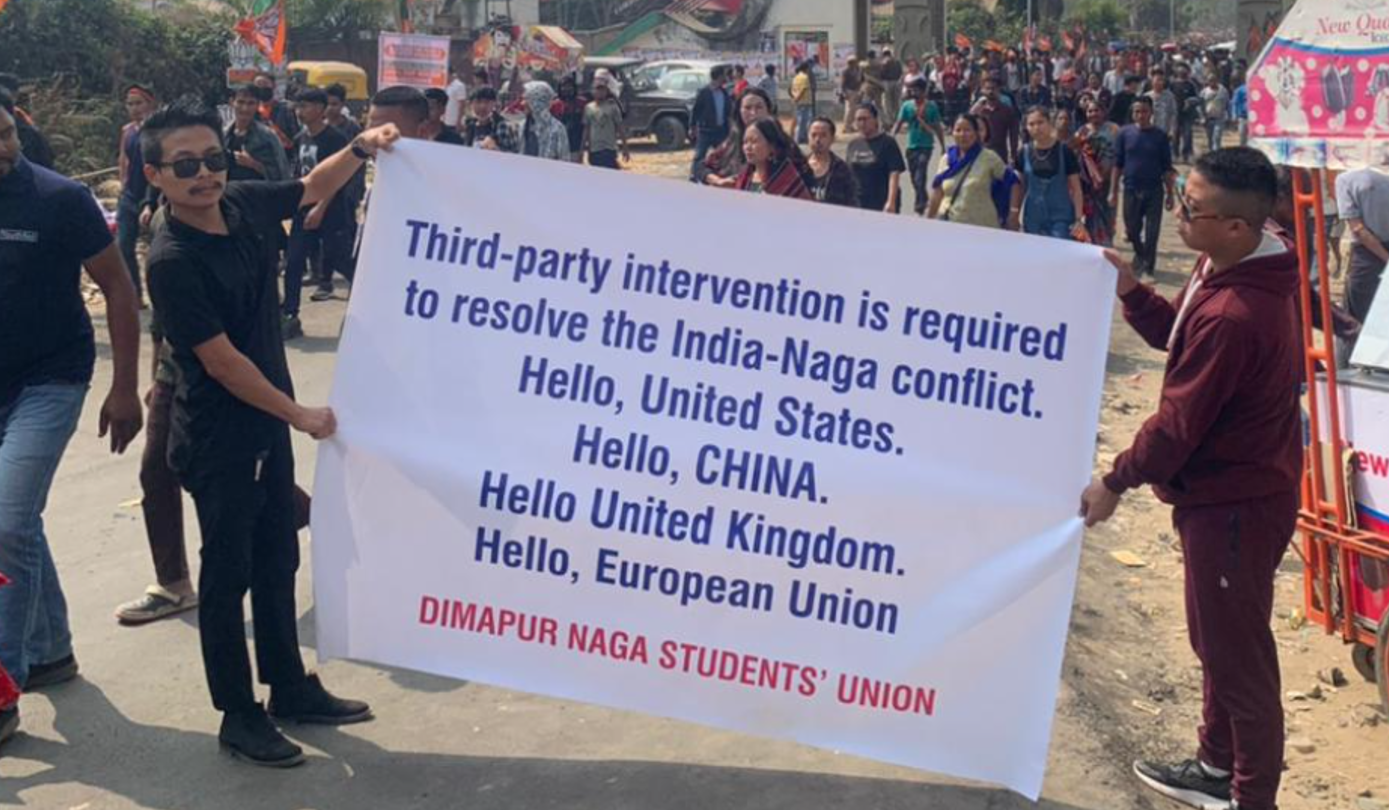It is extremely serious, in part because it is occurring on two fronts at the same time: India imposed election campaigning by India’s Prime Minister Modi in Dimapur, Nagaland to legitimize the election in the state of Nagaland and delegitimize the Naga National Movement; and the Naga student body – the Dimapur Naga Students Union (DNSU) calling for third-party international and United Nations (UN) mediation in resolving the more than seven decades conflict between India and the Naga people. These two approaches, when combined, are well on their way to becoming one of the worst spasms, as both India and the Nagas will push for each goal, which could later flare up the conflict if both decide to take an aggressive stance.
Even if India and the Naga people can bring some of the fighting/war to a halt, for example, through an Indo-Naga ceasefire, all of the underlying problems remain, as demonstrated by the DNSU slogans displayed on February 24, 2023, now much more inflamed and crying out for a far more serious effort to forge a durable solution than has been the case in the conflict to date.


The human and material cost are already staggering. Since the 1950s, many Nagas have died defending their homeland from both India and Myanmar. During the same period, many members of India’s and Myanmar’s military and security forces may have been killed while invading the Naga homeland.
What triggered the conflict?
In 1929, the Naga political memorandum was submitted to the British parliament’s Simon Commission, and the conflict between India, Myanmar, and the Naga people began as the colonial British Empire prepared to leave the region in 1947. The Nagas have stated their political position unequivocally on four occasions:
1. The Nagas did not sign (refused) the 1947 Panglong Agreement, which was instrumental in the formation of the Union of Myanmar (Burma).
2. The Nine-Point Agreement with Akbar Hydari, the Governor of Assam on behalf of India in 1947, but the proposed agreement could not be implemented due to a disagreement over Point 9 – it is now null and void.
3. On August 14, 1947, Naga declared independence from the colonial British empire.
4. Because the Naga declaration of independence did not receive desirable international recognition, a Naga plebiscite was held in 1951 to reaffirm the Naga political position of remaining a free nation. The Nagas overwhelmingly voted for Naga’s sovereign identity.
How India and Myanmar divided the Naga homeland
Under the leadership of Jawaharlal Nehru, Prime Minister of India, and U Nu, Prime Minister of Myanmar, India, and Myanmar began the process of officially dividing the Naga homeland in 1953. The Nagas are now divided into four different administrative regions in India and two different administrative regions in Myanmar.
How did Modi’s India attempt to resolve the Indo-Naga conflict?
In an attempt to resolve the conflict, Modi-led India signed the ‘historic’ Indo-Naga Framework Agreement in 2015, by recognizing the Naga’s legitimate rights as a conflict between the ‘two entities’ rather than India’s internal law and order issue and aligning it very closely with India’s geostrategic regional policies, the Act East Policy (AEP).
The uncertainty over alliance regional geopolitical policies, particularly with the US in countering China in the region, Modi’s India created a Naga conundrum by signing a nearly identical agreement with the Nagas called the ‘Agreed Position‘ to resolve the same conflict. The approach had undoubtedly created uncertainty about the resolution of the conflict, even to this day, and it would not be incorrect to say that Modi’s India had successfully played the power game of when to implement or when not to implement, or simply nullified those signed agreements if it did not benefit its regional geostrategic interests.
REVIEW | Peaceful demonstration by Nagas in front of the G20 FMM venue in Delhi, India – READ HERE
REVIEW | NSF greets Prime Minister of India with demonstration over Indo-Naga conflict amid new government swearing-in ceremony – READ HERE
How is this set of February 24, 2023, events different from previous ones?
While the Nagas boycotted the first Indian-imposed general election in the Naga region in 1952 (Ref: Samaddar, Ranabir (2004). The Politics of Dialogue: Living Under the Geopolitical Histories of War and Peace. Ashgate. pp. 171–173), Modi-led India successfully demonstrated the state of Nagaland is an integral part of India through imposed state election participation and campaigning by India’s Prime Minister Narendra Modi in Dimapur, Nagaland on February 24, 2023, but slogans displayed by the DNSU speak otherwise on the entire truth situation. The DNSU banners and posters displayed at the entry gate of Modi’s election campaign venue questioned clearly and loudly Modi’s commitment and called for concrete international intervention in resolving the Indo-Naga conflict, which has lasted more than seven decades.
Author’s Disclosure Statement: Augustine R. is an independent researcher on the India-Naga-Myanmar political issue, as well as on broader global security and strategic issues. He is also the Editor-in-Chief and Publisher of the International Council of Naga Affairs (ICNA) web publication platform and does not work for, consult for, own shares in, or receive funding from any company or organization that would benefit from this article/opinion.
Featured Image: Call to action banners by Dimapur Naga Students Union (DNSU) on India’s PM Modi’s route to the state election campaign location and in front of the meeting location – Agri Expo, Dimapur, Nagaland on February 24, 2023 / Photos: via Whatsapp / Facebook
ICNA reserves all rights to the content submitted. The author’s views are their own and do not necessarily reflect those of nagaaffairs.org

